#world coronavirus graph
Explore tagged Tumblr posts
Text
Also preseved in our archive (Daily updates!)
By Benjamin Mateus
Stanford University held a conference last month with the misleading title, “Pandemic Policy: Planning the Future, Assessing the Past.” Given the utter bankruptcy of the US and global policy in the ongoing COVID-19 pandemic, one would conclude that a discussion on how the world can address the current and future pandemics is of immense importance and has significant relevance to international public health policies.
However, the one-day conference held at the prestigious university was funded through Collateral Global and supported by Brownstone Institute, promoters of pandemic misinformation and COVID-19 contrarians. It was the opposite of a serious discussion on pandemic preparedness.
To place these organizations into a proper perspective, it bears noting that Robert Dingwall, a British sociologist who has been heavily promoted by Collateral Global, wrote on his blog in March 2020 that the elderly would be better off to die from COVID-19 than to be protected and later die from a degenerative disease like dementia. This was a thinly disguised version of fascistic eugenics—weeding out the “unfit” from society.
The Stanford symposium showcased a panel of discredited scientists and supposed policy health experts associated with the reactionary Great Barrington Declaration, better characterized as a manifesto of death, set on promoting the notion that no broad-based public health initiatives should have ever been undertaken during the COVID-19 pandemic or when the next pandemic strikes.
At the core of the debunked “declaration” is the claim that there can be “focused protection” against the pandemic for those at high risk, which would allow those at minimal risk of death to lead normal lives while building up immunity to the virus through natural immunity.
Well-respected global health advocate Peter Hotez said of the conference, “This is awful, a full-on anti-science agenda (and revisionist history), tone deaf to how this kind of rhetoric contributed to the deaths of thousands of Americans during the pandemic by convincing them to shun vaccines or minimize COVID.”
These include discredited figures like Dr. Jay Bhattacharya, a Stanford public policy professor; Dr. Scott Atlas, former Trump administration adviser on the Coronavirus Task Force; and Anders Tegnell, Sweden’s former state epidemiologist, who advocated for a policy of mass infection to achieve “herd immunity” that had horrendous consequences on the population, in particular, the elderly and most frail. Tegnell’s most consequential remark during the conference gave the flavor of the event: “We have focused so much on mortality as a measure of outcome, but there are more important things.”
Included on the panel were Marty Makary, prominent Johns Hopkins University surgeon, who had repeatedly predicted that the population was on the verge of achieving natural immunity and the pandemic would thus come to an end. Also there was Oxford Professor of Epidemiology Sunetra Gupta, one of the original signers of the declaration with Bhattacharya, and Harvard University biostatistician Martin Kuldorff.
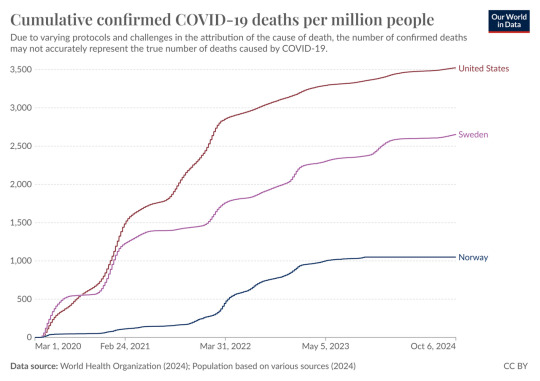
Graph compares COVID deaths in the US, Sweden and Norway (which adopted a far more rigorous pandemic mitigation program). [Photo: Our World in Data] Gupta has called for mass infection of the young and declared during the conference that her idea of focused protection had evolved into what she termed “individual risk reduction,” where each person would decide for him or herself the level of protection and mitigation they wanted to assume during a deadly outbreak. This is the literal opposite of public health, treating infection with a highly contagious and potentially lethal disease as a purely individual matter.
That institutions like Johns Hopkins, Harvard and Stanford are at the forefront of promoting such anti-science and anti-public health initiatives speaks to the deep political and moral decline in academic circles. Similarly, these “elite” institutions have embraced censorship and attacks on democratic rights of students protesting the US backing of Israel’s genocidal policies in Gaza.
Closing remarks at the Stanford conference were given by John Ioannidis, professor of epidemiology and one of the principal investigators of the fallacious, non-peer-reviewed Santa Clara County study, released in April 2020, which suggested that COVID-19 was no deadlier than the flu and that the pandemic measures to protect populations needed to be lifted forthwith.
At the time of that study, the COVID-19 pandemic was inundating the healthcare system of New York City. The CDC had noted that close to 20,000 people had died in the three-month window (March through May) with an overall crude fatality rate of 9.2 percent. Also, 30 percent of hospitalized patients with laboratory confirmed COVID-19 were known to have died.
Bhattacharya, who had locked arms with AFT President Randi Weingarten in forcing students and teachers back into schools in 2021 and served as a pandemic adviser to Florida’s fascistic Governor Ron DeSantis, attempted to sell the conference as a forum for people with opposing views coming together to air out their differences.
“What can we do in the future? The pandemic was by any measure a disaster,” he declared. Although he cited the correct number of deaths and economic turmoil caused by the pandemic affecting the poorest in the world, he blamed these losses, not on the failure to carry out systematic public health measures but on the measures themselves. It was a translation into academic jargon of the notorious declaration by New York Times columnist Thomas Friedman that “the cure can’t be worse than the disease.”
Bhattacharya had the audacity to assert, “this conference was four years too late, but this is not too late, this is not the last pandemic the world will face.” The purpose of his efforts to codify the perspectives put forth by the Great Barrington Declaration is to ensure no real effort is taken by any government to address any threat, including the current bird flu outbreak that threatens to ignite another pandemic.
His ideas have nothing to do with the field of epidemiology or any scientific comprehension of the nature of pandemics. If he has a bone to pick with the Biden administration and its response to the pandemic is that Biden and Harris did not adopt the mass infection policy officially from the beginning, but only implemented it piecemeal.
Additionally, Bhattacharya has positioned himself as a fellow traveler with the anti-vaxxers promoting the false notion that the current mRNA vaccines are unsafe and the process through which they were brought forward violated safety measures which is patently false.
He wrote for the Brownstone Institute a report published on November 16, 2022, stating, “The Biden plan enshrines former president Donald Trump‘s Operation Warp Speed as the model response to the next century of pandemics. Left unsaid is that, for the new pandemic plan to work as envisioned, it will require us to conduct dangerous gain-of-function research. It will also require cutting corners in the evaluation of the safety and efficacy of novel vaccines. And while the studies are underway, politicians will face tremendous pressure to impose draconian lockdowns to keep the population ‘safe’.”
Scott Atlas blurted out the real purpose of the conference. Reading a prepared statement, he said that the lockdowns failed to stop the dying, and they failed to stop the spread. He blamed the economic lockdowns for the excess deaths rather than the virus. He blamed Dr. Anthony Fauci for implementing the lockdowns and not enforcing “targeted protection.”
Atlas later also called for complete US divestment from the World Health Organization and called for the termination of all middle-level scientists at the CDC, for which he received applause from his colleagues on the panel.
The Stanford conference was entirely divorced from the actual history of the pandemic, particularly its early weeks. The initial outbreak of COVID in Wuhan showed it was propagated by airborne transmission and was both highly contagious and lethal.
When, on January 30, 2020, the WHO declared the outbreak a Public Health Emergency of International Concern, Europe, the US, and other countries chose not to act. They could have rapidly eliminated and eradicated the virus but did nothing until the virus had spread globally and began its deadly rampage.
It was in early March, six weeks later, with the horrific scenes emerging out of Italy that prompted the working class to demand a shutdown. Auto workers took the lead in many countries, including the United States and Canada, and it was only out of fear of a mass rebellion among workers internationally that the ruling elites were forced to respond with limited lockdowns to stem the tide of infections.
The Great Barrington Declaration, the right-wing campaigns against mask and vaccine mandates and last month’s conference at Stanford were essentially rooted in fear of the independent initiative of workers insisting on serious in public health measures. The populist demagogy about allowing people the “freedom” to work in the midst of a deadly pandemic cannot disguise what is a fundamentally anti-working class perspective.
The maliciously false point being driven home by the organizers of the conference was that social interventions—masking, closure of schools and businesses, lockdowns, and maintaining social distancing—were worse than the disease, despite studies that have shown when such policies were actually implemented, they saved many, many lives.
As one 2023 study published in The Lancet found, in the period from January 1, 2020, to July 31, 2022, Hawaii, with stricter anti-COVID measures, saw 147 deaths per 100,000 compared to 581 per 100,000 in Arizona and 526 per 100,000 in Washington D.C. The national rate was 372 deaths per 100,000.
Similar conclusions were reached in a more recent comprehensive study that evaluated state by state in the US comparing restrictions in place and impact on excess deaths. As the authors of that study noted, “COVID-19 restrictions were associated with substantial reductions in excess pandemic deaths in the US. If all states had weak restrictions, as defined in the Methods section, estimated excess deaths from July 2020 to June 2022 would have been 25 percent to 48 percent higher than if all had imposed strong restrictions. Behavioral responses provided a potentially important mechanism for this, being associated with 49 percent 78 percent of the overall difference.” This last part of the statement underscores the importance of open channels of communications and an all-in approach to such matters. Public health is first and foremost a social concern.
And still another study published in January 2022 found that the impact of the limited measures employed saved between 870,000 to 1.7 million Americans.
The most insidious issue that the COVID-19 contrarians fail to mention is that herd immunity is not achievable with a virus like SARS-CoV-2, which mutates so rapidly, and the issues raised by Long COVID and reinfections with the concomitant long-term health impacts that will debilitate the population are not even considered. Current estimates place the number of those suffering from Long COVID across the globe at over 410 million as of the end of 2023.
The response to pandemics requires a social investment in public health on an international scale. The global nature of the economy poses that a national approach as was seen in China and its Zero COVID policy cannot withstand an anti-public health policy that is imposed on the global population. This raises the need for a socialist perspective not only to the global economy but to the global health of the working class.
#mask up#covid#pandemic#public health#wear a mask#covid 19#wear a respirator#still coviding#coronavirus#sars cov 2
20 notes
·
View notes
Text
The C19 disease caused by the airborne SARSCOV2 virus is reported to have killed 7 million people from 700 million “cases” over its five years of existence.
Coronavirus Graphs: Worldwide Cases and Deaths - Worldometer
We now know that the number of “cases” is a fiction, borne of a bogus RT-PCR test – probably more than 90% of case diagnoses were false.
Countries like Australia, New Zealand, Germany and Japan managed to avoid the first year of the scamdemic, 2020, by restricting all social interactions – denying life to their citizens. Germany and Japan chose not to use end of life treatments to euthanize those identified as “cases“ with “treatments” like Remdesivir, Midazolam, morphine and fentanyl – and the ventilators/respirators that prevented the “infected” from breathing on medics.
The number of C19 “cases” and deaths with C19 present exploded from 85 million at end of 2020 with around 2 million deaths reported in 2020 - with C19 present using the bogus RT-PCR test.
Note the WHO issued instructions – based on the bogus RT-PCR test – to treat all deaths with a positive test as a C19 death.
Our World in Data reports that 80% of the world’s 8 billion people received 13.7 billion injections.
11 notes
·
View notes
Text
Key Players and Innovations Shaping the Apoptosis Assay Market Size

The Apoptosis Assay Market size was estimated USD 1.52 billion in 2023 and is expected to reach USD 3.21 billion by 2031 at a CAGR of 9.81% during the forecast period of 2024-2031. The Apoptosis Assay Market is rapidly evolving, driven by advancements in biomedical research and the increasing incidence of chronic diseases worldwide. This specialized market caters to the growing demand for precise and efficient methods to detect and quantify apoptotic cells, crucial for understanding disease mechanisms and developing targeted therapies. Innovations in assay technologies, such as flow cytometry, fluorescent microscopy, and PCR-based assays, are expanding the capabilities of researchers to analyze apoptosis with higher sensitivity and specificity. Additionally, the integration of artificial intelligence and machine learning algorithms is enhancing data interpretation and accelerating drug discovery processes. With a rising emphasis on personalized medicine, the apoptosis assay market is poised for significant growth, promising novel insights into cellular pathways and offering new avenues for therapeutic intervention in complex diseases like cancer and neurodegenerative disorders.
Get Sample Of The Report @ https://www.snsinsider.com/sample-request/3942
Market Scope & Overview
The Apoptosis Assay Market report's main goal is to provide readers with a better understanding of the industry, including market segmentation, potential, significant trends, and issues that developed and emerging nations must deal with. The research report's objective is to show how the current situation, the economic downturn, and COVID-19 have an impact on the entire industry.
The latest research report on Apoptosis Assay Market market provides a thorough analysis of the factors affecting the scope of the global market. Our researchers, who keep an eye on the situation around the world, predict that the market will offer lucrative business opportunities for market participants.
Market Segmentation Analysis
By Assay Type
Caspase Assay
DNA Fragmentation Assay
Cell Permeability Assay
Mitochondrial Assay
By Product
Kits
Reagents
Instruments
By Technique
Flow Cytometry
Fluorescence Microscopy
Spectrophotometry
Other Techniques
By End User
Pharmaceutical & Biotechnology Companies
Hospital & Diagnostic Laboratories
Academic & Research Institutes
COVID-19 Impact Analysis
We routinely monitor Apoptosis Assay Market changes and consumer behavior as the distinct coronavirus (COVID-19) problem spreads throughout the world. Then, while predicting the most recent market trends and forecasts, we take the epidemic's effects into account. Market participants who are developing strategies for pandemic-like events may find this information useful.
Regional Outlook
To predict the future course of the global Apoptosis Assay Market , advancements in each region are graphed using precise historical data. To evaluate the strengths, weaknesses, opportunities, and threats that these companies anticipate will exist throughout the projected period, a SWOT analysis is conducted.
Competitive Analysis
The most recent study carefully examines the businesses that compete in the Apoptosis Assay Market, including those that serve as suppliers of raw materials, equipment, end users, traders, and distributors. By carefully analyzing current supply and demand patterns, critical financial information of significant market participants, and the market's impact of recent economic changes, the research is intended to provide a 360-degree analysis of the global market.
Key Reasons to Buy Apoptosis Assay Market Report
We can give you any extra details that aren't covered by the report as part of the research customization.
The competitive landscape section of the report contains comprehensive profiles of the key companies operating in the sector.
The research report covers impact analysis for COVID-19 pandemic period and post pandemic phase.
Conclusion
The Apoptosis Assay Market research report will help industry participants understand the strategies used by prosperous companies to prosper in the recent global market.
Read Full Report @ https://www.snsinsider.com/reports/apoptosis-assay-market-3942
About Us
SNS Insider is a market research and insights firm that has won several awards and earned a solid reputation for service and strategy. We are a strategic partner who can assist you in reframing issues and generating answers to the trickiest business difficulties. For greater consumer insight and client experiences, we leverage the power of experience and people.
When you employ our services, you will collaborate with qualified and experienced staff. We believe it is crucial to collaborate with our clients to ensure that each project is customized to meet their demands. Nobody knows your customers or community better than you do. Therefore, our team needs to ask the correct questions that appeal to your audience in order to collect the best information.
Related Reports
BOTOX Market Growth
Botulinum Toxin Market Growth
Bovine Mastitis Market Growth
Brain Tumor Drugs Market Growth
Breast Cancer Therapeutics Market Growth
0 notes
Text
Antiviral Herbal Product Market to see Booming Business Sentiments

The Latest research coverage on Antiviral Herbal Product Market provides a detailed overview and accurate market size. The study is designed considering current and historical trends, market development and business strategies taken up by leaders and new industry players entering the market. Furthermore, study includes an in-depth analysis of global and regional markets along with country level market size breakdown to identify potential gaps and opportunities to better investigate market status, development activity, value and growth patterns. Access Sample Report + All Related Graphs & Charts @: https://www.advancemarketanalytics.com/sample-report/163223-global-antiviral-herbal-product-market
Major & Emerging Players in Antiviral Herbal Product Market:- Apotheca Inc. (United States), Gaia Herbs (United States), Kunnath Pharmaceuticals (India), Growrich Agrotech India Private Limited (India), Sushil Corporation (India), HerbalHills (India), Airen Herbal (India), Inbiota (India), Ancient GreenFields Pvt. Ltd. (India). The Antiviral Herbal Product Market Study by AMA Research gives an essential tool and source to Industry stakeholders to figure out the market and other fundamental technicalities, covering growth, opportunities, competitive scenarios, and key trends in the Antiviral Herbal Product market. Herbal medicines and purified natural products provide a rich resource for novel antiviral drug development. Identification of the antiviral mechanisms from these natural agents has shed light on where they interact with the viral life cycle, such as viral entry, replication, assembly, and release, as well as on the targeting of the virus–host-specific interactions. The emergence of dengue virus, influenza virus, measles virus, severe acute respiratory syndrome (SARS) virus, and West Nile virus outbreaks has led to significant growth of the global antiviral herbal product market in the upcoming years.
The titled segments and sub-section of the market are illuminated below: by Virus (Coronavirus, Coxsackievirus, Dengue virus, Enterovirus 71, Hepatitis B virus, Hepatitis C virus, Herpes simplex virus, Influenza virus, Others), Herbs (Oregano, Sage, Basil, Fennel, Garlic, Lemon balm, Aloe vera, Ginger, Others), Packaging Type (50 ML, 100 ML, 250 ML, Others), End User (Pregnant Women, Adults, Pediatric, Geriatric) Market Trends: Increasing Demand for Herbal medicines Developing World for Primary Healthcare
Opportunities: Exponentially Rising Inclination of Patients Towards Alternate and Herbal Therapy in the Developing Nations like India
Market Drivers: Increasing Worldwide Health Concern Among the People
Rising Viral Infections and Emerging and Chronic Viruses
Challenges: Lack of Awareness about Antiviral Herbal Product in the Some Countries Enquire for customization in Report @: https://www.advancemarketanalytics.com/enquiry-before-buy/163223-global-antiviral-herbal-product-market Some Point of Table of Content: Chapter One: Report Overview Chapter Two: Global Market Growth Trends Chapter Three: Value Chain of Antiviral Herbal Product Market Chapter Four: Players Profiles Chapter Five: Global Antiviral Herbal Product Market Analysis by Regions Chapter Six: North America Antiviral Herbal Product Market Analysis by Countries Chapter Seven: Europe Antiviral Herbal Product Market Analysis by Countries Chapter Eight: Asia-Pacific Antiviral Herbal Product Market Analysis by Countries Chapter Nine: Middle East and Africa Antiviral Herbal Product Market Analysis by Countries Chapter Ten: South America Antiviral Herbal Product Market Analysis by Countries Chapter Eleven: Global Antiviral Herbal Product Market Segment by Types Chapter Twelve: Global Antiviral Herbal Product Market Segment by Applications What are the market factors that are explained in the Antiviral Herbal Product Market report?
– Key Strategic Developments: Strategic developments of the market, comprising R&D, new product launch, M&A, agreements, collaborations, partnerships, joint ventures, and regional growth of the leading competitors.
– Key Market Features: Including revenue, price, capacity, capacity utilization rate, gross, production, production rate, consumption, import/export, supply/demand, cost, market share, CAGR, and gross margin.– Analytical Tools: The analytical tools such as Porter’s five forces analysis, SWOT analysis, feasibility study, and investment return analysis have been used to analyze the growth of the key players operating in the market. Buy This Exclusive Research Here: https://www.advancemarketanalytics.com/buy-now?format=1&report=163223 Definitively, this report will give you an unmistakable perspective on every single reality of the market without a need to allude to some other research report or an information source. Our report will give all of you the realities about the past, present, and eventual fate of the concerned Market. Thanks for reading this article; you can also get individual chapter wise section or region wise report version like North America, Europe or Asia. Contact US : Craig Francis (PR & Marketing Manager) AMA Research & Media LLP Unit No. 429, Parsonage Road Edison, NJ New Jersey USA – 08837 Phone: +1 201 565 3262, +44 161 818 8166 [email protected]
#Global Antiviral Herbal Product Market#Antiviral Herbal Product Market Demand#Antiviral Herbal Product Market Trends#Antiviral Herbal Product Market Analysis#Antiviral Herbal Product Market Growth#Antiviral Herbal Product Market Share#Antiviral Herbal Product Market Forecast#Antiviral Herbal Product Market Challenges
0 notes
Text
Course Creation Software Market to Witness Excellent Revenue Growth Owing to Rapid Increase in Demand
Latest released the research study on Global Course Creation Software Market, offers a detailed overview of the factors influencing the global business scope. Course Creation Software Market research report shows the latest market insights, current situation analysis with upcoming trends and breakdown of the products and services. The report provides key statistics on the market status, size, share, growth factors of the Course Creation Software The study covers emerging player’s data, including: competitive landscape, sales, revenue and global market share of top manufacturers are iSpring Solutions (United States), Udemy, Inc. (United States), Asentia LMS (United States), Crowd Wisdom (United States), Lessonly (Seismic) (United States), SkyPrep (Canada), Adobe (United States), Lectora (eLearning Brothers) (United States), Easygenerator (Netherlands), Coassemble (Australia), Spayee (India)
Free Sample Report + All Related Graphs & Charts @: https://www.advancemarketanalytics.com/sample-report/111046-global-course-creation-software-market?utm_source=Organic&utm_medium=Vinay
Course Creation Software Market Definition:
Course creation software allows course creators to create, design, and deliver virtual learning material for educational and training purposes. The use of technology enables users to create courses with interactive multimedia content including video, graphs, images, etc. that offers enhanced learning experience to the targeted audiences. The evolution of e-learning in the education and training world increased the demand for cutting-edge technological solutions to create online courses. However, the outbreak of coronavirus led businesses and schools or universities to remain shut or operate remotely. This has increased the adoption of online learning for education or to train employees working remotely. In today’s time, many colleges and universities across the globe have been offering distance learning, which will create significant opportunities for the market.
Market Trend:
The Use of Advanced Technologies Such As Big Data and AI
Market Drivers:
High Adoption of E-learning Tools and Solutions in Schools and Home
Increasing Demand of Video-Based and Microlearning for Corporate Training
Market Opportunities:
Growing Popularity of Distance Learning in the Education Sector
The Global Course Creation Software Market segments and Market Data Break Down are illuminated below:
by Organization Size (Small and Medium Businesses, Large Businesses), Deployment (Cloud, On-premises), End-user (Schools & Universities, Educational Institutions, Corporates, Course Authors, Others), Operating System (Windows, IOS, Android)
Region Included are: North America, Europe, Asia Pacific, Oceania, South America, Middle East & Africa
Country Level Break-Up: United States, Canada, Mexico, Brazil, Argentina, Colombia, Chile, South Africa, Nigeria, Tunisia, Morocco, Germany, United Kingdom (UK), the Netherlands, Spain, Italy, Belgium, Austria, Turkey, Russia, France, Poland, Israel, United Arab Emirates, Qatar, Saudi Arabia, China, Japan, Taiwan, South Korea, Singapore, India, Australia and New Zealand etc.
Enquire for customization in Report @: https://www.advancemarketanalytics.com/enquiry-before-buy/111046-global-course-creation-software-market?utm_source=Organic&utm_medium=Vinay
Strategic Points Covered in Table of Content of Global Course Creation Software Market:
Chapter 1: Introduction, market driving force product Objective of Study and Research Scope the Course Creation Software market
Chapter 2: Exclusive Summary – the basic information of the Course Creation Software Market.
Chapter 3: Displayingthe Market Dynamics- Drivers, Trends and Challenges of the Course Creation Software
Chapter 4: Presenting the Course Creation Software Market Factor Analysis Porters Five Forces, Supply/Value Chain, PESTEL analysis, Market Entropy, Patent/Trademark Analysis.
Chapter 5: Displaying market size by Type, End User and Region 2015-2020
Chapter 6: Evaluating the leading manufacturers of the Course Creation Software market which consists of its Competitive Landscape, Peer Group Analysis, BCG Matrix & Company Profile
Chapter 7: To evaluate the market by segments, by countries and by manufacturers with revenue share and sales by key countries (2021-2026).
Chapter 8 & 9: Displaying the Appendix, Methodology and Data Source
Finally, Course Creation Software Market is a valuable source of guidance for individuals and companies in decision framework.
Data Sources & Methodology The primary sources involves the industry experts from the Global Course Creation Software Market including the management organizations, processing organizations, analytics service providers of the industry’s value chain. All primary sources were interviewed to gather and authenticate qualitative & quantitative information and determine the future prospects.
In the extensive primary research process undertaken for this study, the primary sources – Postal Surveys, telephone, Online & Face-to-Face Survey were considered to obtain and verify both qualitative and quantitative aspects of this research study. When it comes to secondary sources Company's Annual reports, press Releases, Websites, Investor Presentation, Conference Call transcripts, Webinar, Journals, Regulators, National Customs and Industry Associations were given primary weight-age.
For Early Buyers | Get Up to 20% Discount on This Premium Report: https://www.advancemarketanalytics.com/request-discount/111046-global-course-creation-software-market?utm_source=Organic&utm_medium=Vinay
What benefits does AMA research study is going to provide?
Latest industry influencing trends and development scenario
Open up New Markets
To Seize powerful market opportunities
Key decision in planning and to further expand market share
Identify Key Business Segments, Market proposition & Gap Analysis
Assisting in allocating marketing investments
Definitively, this report will give you an unmistakable perspective on every single reality of the market without a need to allude to some other research report or an information source. Our report will give all of you the realities about the past, present, and eventual fate of the concerned Market.
Thanks for reading this article; you can also get individual chapter wise section or region wise report version like North America, Europe or Southeast Asia.
Contact Us:
Craig Francis (PR & Marketing Manager) AMA Research & Media LLP Unit No. 429, Parsonage Road Edison, NJ New Jersey USA – 08837
0 notes
Text
The Weight of 2020
When did it start? The first time you put on a mask, fabric trapping your breath? The first day of quarantine, when you gazed out the window at streets so barren, it was like everyone was already dead? The first time you heard the phrase ‘novel coronavirus’, before ‘novel’ became ‘new normal’? Or was it when you realized the pandemic was a string of firsts with no lasts? If the story of sickness has no beginning, how can you expect it to end?
Sometimes, it starts with a whisper– start small, skip breakfast. I hear it many times before I listen. You know you’re sick when a fever spikes, but the virus was waiting within you for days, even weeks. You were carrying the disease all along.
High temperature. Shortness of breath. Lunches emptied into the trash, untouched. I can get away with it; I eat alone. I was quarantined before it was cool. I sit in silence as my body burns, wishing the flames would devour me faster. Loss of appetite, loss of taste. It’s not so different, after all.
Nausea, vomiting– the same nights hunched over, heave and splatter. Is it the sickness, or is it me? Did I choose this? I didn’t catch it. I guess that makes it my fault. As I empty myself of all that I am– you are what you do not eat– I feel her watching from the mirror.
An issue of self-image– the self and the image refuse to be joined. They are much more than a hyphen apart, lacking the quickness of Covid-19, uttered in a single hushed breath. Self. Image. Illness isolates; you become well-acquainted with the separate self.
Rising numbers. Flatten the curve. Fear is a line graph angling steeply toward an unseen zenith, stolen moments of normalcy shattered by too much, too much, too much! It haunts me, like the silence that falls after a cough in the supermarket, the cessation of safety, sanity. The resuming clatter of carts cannot lighten air left leaden, laden.
When you’re sick, you want to get well. I don’t want to be well; I want to be nothing. I don’t want to rest, drink water, breathe. What I really want is to erase myself, but there’s no escape from the grotesqueness of flesh, the ghoul in the mirror.
It’s not my body—all the forgiveness I do not have weighs on me. If there was ever a time to forget compassion, it would be now. You expect, somewhere between the hoarding and hysteria, for the mask of humanity to slip. I expected it, in my animal brain of hurts and hungers, but I was proven wrong.
A week after the graduation I never had, I tried to carry a box. It was light, but I was weak, and getting to the post office, half a mile from my shell of a dorm room, was more than I could bear.
It wasn’t just the box. It was the gaping windows, lifeless eyes in the ruins of buildings still standing; Van Hise, where the elevators skipped floors 2-5; the humanities building, a concrete maze; the English building, where I should have gone to the award ceremony senior year, but the one year I won, the whole world lost. It was all the detritus of my former life suspended around me that made my task unbearable.
I was painfully aware of my tight breath, aching back, trembling hands. Trembling– what I was doing felt more violent, like tearing myself apart. My hands shook for hours afterward, but when I found myself collapsing under the weight of 2020, I dropped my box, and two girls picked it up. We were in a pandemic, but they saw my suffering body and rushed to its aid when I only ever saw myself as an adversary, an illness. To them, I was human.
So, I went to the hospital. My disease was not the one on anyone's lips, least of all mine. Even then, I was alone in the deepest way, too sick to be contagious. I wished I could have coughed to spread my pain. I laid there, staring at white ceilings, quarantined in my own head.
Recovery. For some, illness spends itself in days. In others, it lingers for months, years. Healing never happens all at once, in a moment of truth, the second we choose to get better. How do you know when you’re finally well? How do you know when the pandemic’s over?
How do you vaccinate for anorexia?
#original fiction#flash fiction#covid#tw ed#recovery#I wrote this back when I was going to a local writer's workshop last fall but I don't think I ever posted it
1 note
·
View note
Text
Econ in masks!
Youhan Zhou
91395705
Wednesday 5 p.m.
Why a mask?
The year 2019 ended with such a sudden outbreak of pandemic in all countries. It was a painful memory for all. For me, too, my first academic year at UCI forced me to spend my days and nights in China for online classes. Those painful memories aside, the masks were the thing that made the biggest difference in people's lives. Everyone was required to wear a mask outside. On the streets, you could see everyone wearing N95 masks or medical masks. The stores and Wal-Marts were full of people wearing masks. The world was permanently changed one day in 2019. These changes lasted until 2022, when they were gradually eliminated. Without a doubt, the masks are the thing that has had the most impact on my life.
Why connect to the economy?
As a commodity, masks are naturally influenced by the economy. During an epidemic, the price of masks fluctuates constantly, but a general trend always keeps rising. Part of the masks is distributed to everyone as a public benefit, and parts are also produced privately. Therefore, masks can be classified as Private Goods or Public Goods, but even with the Public Goods attribute, the government cannot stop the price of masks from rising.

The graph above depicts my understanding of the rising price of masks. Many residents tried to overbuy masks with the outbreak to meet future demand. So, the demand for masks created a shift to the right. Finally, the price of masks was raised rapidly. The demand for masks is also shifted to the right to achieve market equilibrium. This leads to the fluctuation of the market price.

This volatility has not stopped the price of masks from rising. "On Amazon, one pack of disposable masks that was priced at $125 on Sunday surged to $220 per pack on Wednesday, according to data from Keepa, which tracks price changes on Amazon. "That's because the demand for masks is much greater than the production. Everyone is overstocking masks to meet future demand. This phenomenon has led to the price of masks rising even as the government and factories continue to produce them. As a fully competitive commodity, masks should have quickly returned to the supply and demand market balance. However, this did not happen. As you can imagine, this is due to the rising demand. This also explains why market prices fluctuate. When demand increases, factories increase production to meet the public's demand to hit the equilibrium point. But this expanded production does not meet the demand for unlimited stockpiling of masks. This causes prices to rise again before they return to the equilibrium point. Of course, such fluctuations are not limited to market equilibrium; many other factors contribute to this phenomenon. These factors include speculation by speculators, among others.
Work cited:
Brown, Dalvin. “Medical Mask Prices Surge on Amazon after CDC Comments on Coronavirus in the U.S.” USA Today, Gannett Satellite Information Network, 26 Feb. 2020, https://www.usatoday.com/story/money/2020/02/26/coronavirus-prices-masks-amazon-surging/4878653002/.
0 notes
Text
Kevin Yu - 91652909 Wenqi Song - 19097398 America Garcia - 52606257 Edward Kim - 40798622
On March 11, 2020, the World Health Organization declared Covid-19 a global pandemic. This set a domino effect for all industries, people, and places around the world. In the U.S., businesses and schools quickly pivoted to distanced and online formats, people were forced to stay at home, and we experienced the quickest recession in the history of this country. One industry, however, was hit harder than most: the airline industry.
With all the shutdowns and travel bans around the world, aviation seemingly hit rock bottom overnight. Airlines’ main service for customers is flights, so without being able to fly even at a fraction of the capacity that they previously could, their main source of revenue was essentially eliminated. This impact on the airline industry was not merely felt here in the United States, but around the world, in some cases even more so. Take a look at the graphic below and one can understand the type of impact that was felt.
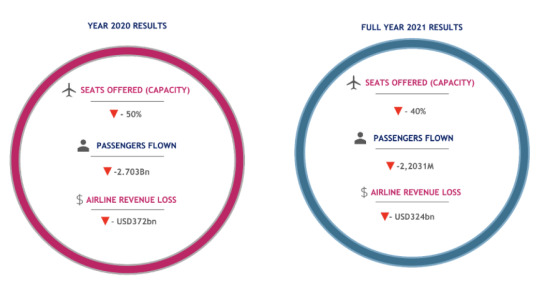
This impact hit the smallest of airlines the hardest. The biggest airlines in the world—think United or Delta—were able to survive the pandemic by using their fleets to fly cargo, charter, and repatriation flights. Unfortunately, many smaller airlines were unable to do so, and as of February 11, 2023, 64 airlines have gone bankrupt during the pandemic.
Although the airline industry is poised to bounce back and the future is looking brighter, it is a fact that the Covid-19 pandemic has changed civil aviation forever. In this blog, we are going to examine the impact of Covid-19 and subsequent events and policies on the airline industry during the peak of Covid-19 in 2020 and 2021 by examining the busiest trans-Atlantic route in the world: London (LHR) - New York (JFK).
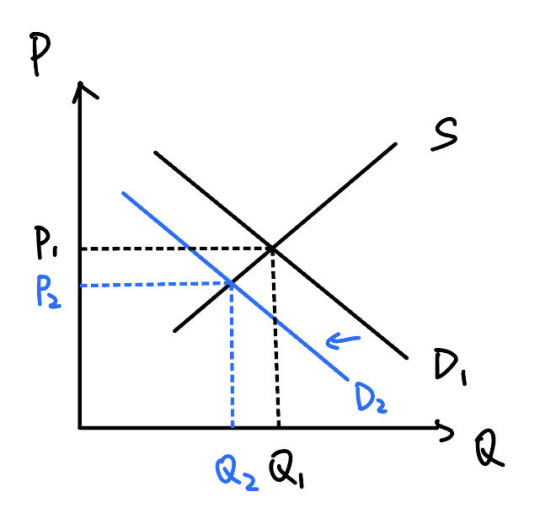
Based on the graph above, there is a shift to the left for demand as the amount of interest in purchasing airplane tickets would decrease due to the restrictions involved from government during the incidents of the CoronaVirus. Due to this shift, in order to offset the changes, the quantity amounts needed for people to purchase need to be increased resulting in the prices for airplane tickets to decrease as some of the reasoning to why people would not want to purchase the tickets could be factors of self-quarantine/isolation for a 14 day period before being lifted as well as fear for the virus spread. Decreasing the price in turn would result in some people being interested or affect people in deciding whether or not to purchase.

Within this graph, we could see that the blue box would represent the consumer surplus meaning that is the price the consumer would pay based on the difference between the maximum customers are willing to pay to the equilibrium market price. In this case, the consumer surplus would be a small amount due to the fact of Coronavirus resulting in fewer people being interested in purchasing the tickets as well as the amount of worth provided on a quarantine isolation requirement. Whereas the producer surplus is the difference between the highest amount a consumer is content to pay for the product with the product market price. Similar to the factors seen in the consumer surplus, the producer surplus would also be at a smaller space as the effects of the Coronavirus results in people being less likely to find high amounts of worth for their product being the airplane tickets during a time of crisis and fear.
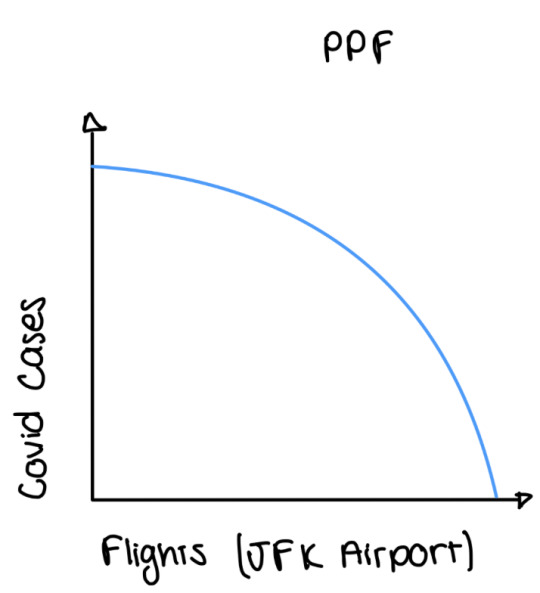
The graph would show an increasing opportunity cost due to how the amount of flights traveling within the JFK airport results in an increased value for the amount of Covid cases found. As airplane travels were to increase, the spread of the Corona virus would increase at an exponential rate, whereas with less cases of Coronavirus involving air travel would be at a small rate based on the amount of passengers willing to travel. As there has been a connection between the rates for Covid cases and airplane flights found within the JFK airport, Covid cases increase based on the more flights held within the JFK airport. With less space in the airplane and even fewer flights held, the amount of Coronavirus cases would decrease by a bit compared if there were more flights held.
Overall, this example was quite relevant to our daily lives during the peak of the pandemic. During the summer of 2020, our group member, Kevin, had made plans to travel to Europe. One of us specifically had already booked flights at the end of 2019 and was planning a nice trip. Unfortunately, after the pandemic hit, he requested a refund. Luckily, he had travel insurance so he was able to get his money back. Regardless if the government stepped in, he would not have gone on the trip as he originally planned because of fear and concern that was caused by Covid-19. Like him, millions around the world canceled their travel plans because of this concern. This indicates a clear decrease in the market demand for flights, and this greatly shook the airline industry. Only time will tell when the industry will stabilize.
0 notes
Text
A Microeconomic Analysis of my Experience during the COVID-19 Pandemic
COVID-19 undoubtedly had a drastic effect on many peoples' lives as it spread around the globe. One such impact is the way it altered many of our routines and consumption preferences, including the way we dine.
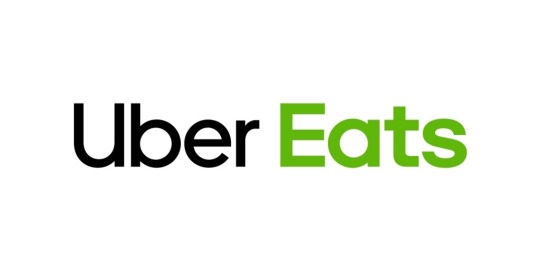
Uber Eats (2023). [Uber Eats logo].
At the height of the pandemic I was in the middle of my second year at community college, and like many people, I had a lot of spare time. I figured I should look for work and eventually signed up for the food delivery service, UberEats. The business works by contracting ordinary people who own a vehicle to deliver food from restaurants to private households. Before the pandemic struck, platforms like this were large, but still burgeoning. Prior to the height of the pandemic I was curious about the app and asked friends what sort of pay they were receiving to do deliveries for UberEats. At first, I was underwhelmed when I heard that they were making anywhere from $10 to $15 for an hour of work. Once the pandemic struck however, the growth of the industry really took off. The graphic below comes from an article entitled “The Pandemic has More than Doubled Food-Delivery Apps’ Business. Now What?” written by tech reporter Levi Sumagaysay of MarketWatch. What the visual shows is that UberEats and many other platforms brought in considerably more revenue in Q3 of 2020, at the height of the Coronavirus pandemic, compared to Q2 of 2019.
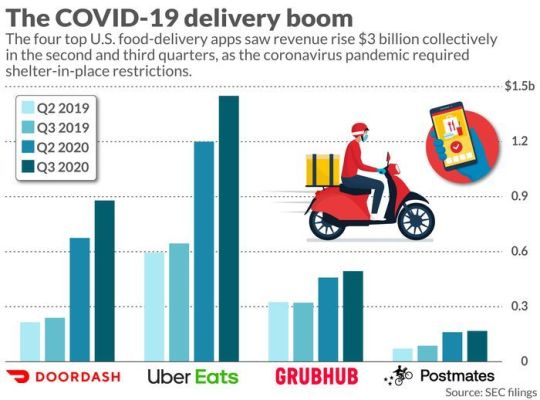
Market Watch (2023). [The COVID-19 Delivery Boom].
Around the same time, I had once again asked my friends who had signed up for the app what their pay was and they told me they were now making anywhere from $20 to $25 an hour. Hearing this, I eagerly signed up and started doing deliveries. The growth of this industry and my decision to enter the job market could be understood through the concepts of supply and demand and producers’ willingness to sell. There are several firms in this industry and they all supply mostly identical products so we can say that the market for food delivery apps is roughly competitive. Though real world markets are more complicated than perfectly competitive models, granting a few simplifying assumptions can provide some useful explanation of these developments. For instance, the pay increase that me and my friends observed and the increased revenue these firms were generating could be attributed to a shift in market demand for UberEats. A factor that might increase the quantity of food deliveries demanded at every price level is a change in consumer preference.

UC Berkley (2023). [Social Distancing].
Because people were afraid of getting sick, they stayed indoors more often and their preferences went away from in-person dining, towards contactless food delivery. This increase in demand would induce upward pressure on the market clearing price as well as the quantity of deliveries supplied by the typical firm at the point where their marginal revenue equals their marginal cost. From the perspective of UberEats, the marginal revenue they get from the output which is equal to the new market price has increased, incentivizing them to produce more deliveries. In this graph below, this is depicted by an increase in quantity supplied by the firm from Q*1 to Q*2.
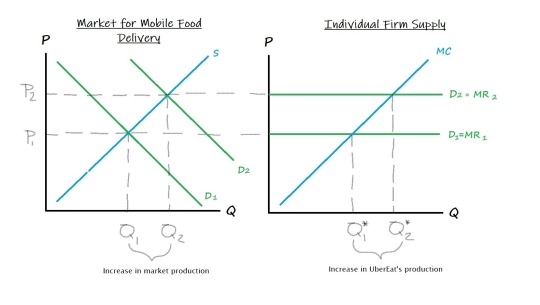
In order to supply a greater quantity at Q*2 however, a firm in this market will need more inputs for production, one of which being labor. Seeing opportunity for greater profits, firms like UberEats would have a need for more delivery drivers that perform the actual delivery service. At every price level, the quantity demanded for delivery drivers would increase. Graphically this can be represented by a shift rightward in the demand curve in the labor market, which we also take to be competitive. The labor market, which is governed by the same laws of supply and demand as any other competitive market, would see an increase in both quantity supplied and price at equilibrium due to the increased employer demand. What this meant for drivers, myself included, was that the number of job openings increased and the typical wage they received for their work went up.
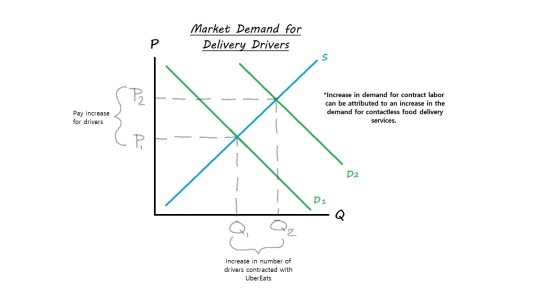
Consequently, both surplus for consumers (employers) and surplus for suppliers (drivers) grew. This is because the willingness for employers to pay for labor less the cost they paid for it as well as the willingness for drivers to sell their labor subtracted from the pay they earned both increased. The surplus for employers such as UberEats and drivers before and after the increase in demand can be represented by a graph of total surplus. In the graph shown below, following the demand shift, the area encompassing employer surplus increased from E+B to E+F . Likewise, the area encompassing drivers’ surplus went from A to A+B+C+D. The increase in total surplus attributed to demand shift is visually represented by the regions C+D+F.
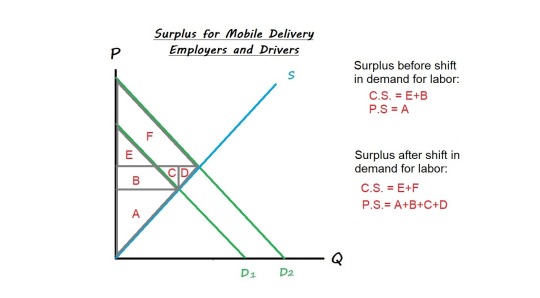
Because the increase in pay that drivers were receiving surpassed the minimum dollar amount that I was willing to sell my labor for, I decided to sign up for the app. The surplus I received from this decision would be captured in the region D which represents the increase in producer surplus attributed to all new driver entrants in the market. Since new entrants such as myself could offer services at a lower cost compared to those who refrained from entering the market despite the pay increase, overall economic well being increased. What this demonstrates is that even under tumultuous circumstances like a global pandemic, markets are resilient and an economy with versatile supply and demand benefits society as a whole.
Works Cited:
Sumagaysay, Levi. “The Pandemic Has More than Doubled Food-Delivery Apps’ Business. Now What?” MarketWatch, 27 Nov. 2020, www.marketwatch.com/story/the-pandemic-has-more-than-doubled-americans-use-of-food-delivery-apps-but-that-doesnt-mean-the-companies-are-making-money-11606340169.
Uber Eats (2023). [Uber Eats logo]. Retrieved from https://www.ubereats.com/
UC Berkley (2023). [Social Distancing Clipart]. Retrieved from https://supplychain.berkeley.edu/supply-chain-responses-covid-19
Carlos J. Berton
UCID: 42647315
ECON 20A DIS 62141 (Fridays @ 12pm)
0 notes
Text
here’s every U.S.-relevant COVID-tracking link i’ve saved:
https://www.who.int/emergencies/diseases/novel-coronavirus-2019/situation-reports
does anyone have any reliable sources for current COVID stats? especially wastewater stats? idk if the ones im using are accurate anymore.
9 notes
·
View notes
Text
Coronavirus: Over 29 Lakh Covid-19 Cases In India, Recovery Rate Jumps To 74% | Check Important Figures
Coronavirus: Over 29 Lakh Covid-19 Cases In India, Recovery Rate Jumps To 74% | Check Important Figures
[ad_1]
Coronavirus In India: India on Friday witnessed another massive spike of over 68,000 new Coronavirus cases taking the overall tally beyond 29 lakh mark. 68,898 Covid-19 cases and 983 deaths reported in India, in the last 24 hours, Ministry of Health and Family Welfare said. Also Read: Good New For Delhiites! Coronavirus Doubling Rate Climbs To Over 100 Days, Mortality Rate Dips…
View On WordPress
#coronavirus cases in punjab#coronavirus count in india#coronavirus daily gbtnews#coronavirus data gbtnews#coronavirus death rate#coronavirus disease gbtnews#coronavirus in punjab#coronavirus india wiki#coronavirus recovery rate in india#coronavirus update gbtnews#coronavirus vaccine news update#coronavirus vaccine russia#coronavirus world wise list#covid coronavirus vaccine#essay on coronavirus in hindi#india covid tracker live#mohfw#poster making on coronavirus#russia vaccine#world coronavirus graph
0 notes
Photo

Seems like the number of Covid19 cases in the world is flatlining. The lockdowns in the world is starting to work.
#corona#coronavirus#flatline#covid2019#stastic#data#graph#coronagraph#world#lockdown#corona viris#worldtoday#safetheword#stayathome#quaratine
1 note
·
View note
Text
ऑफिस टाईममध्ये बदल होणार? मुख्यमंत्र्यांनी थेट PM मोदींकडे केली महत्त्वाची मागणी The Chief Minister uddhav thackeray made an important demand to PM narendra Modi mhas | National
ऑफिस टाईममध्ये बदल होणार? मुख्यमंत्र्यांनी थेट PM मोदींकडे केली महत्त्वाची मागणी The Chief Minister uddhav thackeray made an important demand to PM narendra Modi mhas | National
बैठकीत मुख्यमंत्री उद्धव ठाकरे यांनी महत्त्वाची मागणी केली आहे. मुंबई, 20 फेब्रुवारी : नीती आयोगाची सहावी बैठक आज आयोजित करण्यात आली होती. पंतप्रधान नरेंद्र मोदी यांच्या अध्यक्षतेखाली दूरदृश्य प्रणालीद्वारे झालेल्या या बैठकीत मुख्यमंत्री उद्धव ठाकरे यांनी महत्त्वाची मागणी केली आहे. कार्यालयीन वेळांमध्ये बदल करण्यात यावा, असं उद्धव ठाकरे यांनी म्हटलं आहे. ‘कोविडचा लढा संपलेला नाही. आपणही व्हीसी…

View On WordPress
#china coronavirus#corona graph#corona in noida#corona meaning english#corona meaning in marathi#corona structure#corona vaccine update#corona virus in noida#corona virus india#corona virus update in india#coronavirus#coronavirus cases in world#coronavirus in gujarat#coronavirus in pakistan#coronavirus india count#coronavirus italy#coronavirus pakistan#coronavirus update india#icmr#icmr full form#icmr report#india coronavirus cases#india coronavirus count#italy coronavirus#Narendra Modi#nirbhaya hanging#pakistan coronavirus#PM Narendra Modi#positive cases#pune
0 notes
Text
Exploring the Market Size of 4D Printing in Healthcare

The 4D Printing in Healthcare Market Size was valued at USD 30.45 billion in 2023 and is expected to reach USD 124.23 billion by 2031 and grow at a CAGR of 19.21% over the forecast period 2024-2031.The 4D printing in healthcare market represents a revolutionary advancement in medical technology, harnessing the dynamic capabilities of smart materials that can transform over time. Unlike traditional 3D printing, 4D printing involves materials designed to respond to environmental stimuli such as temperature, light, and moisture, enabling the creation of adaptive and self-evolving medical devices. This innovation has the potential to revolutionize various aspects of healthcare, from creating stents that adjust to changes in a patient's body to developing custom-made implants that promote better integration and healing. As the market evolves, it promises to enhance patient-specific treatments, reduce surgical risks, and improve overall patient outcomes, paving the way for more personalized and efficient medical solutions.
Market Scope & Overview
The 4D Printing in Healthcare Market report's main goal is to provide readers with a better understanding of the industry, including market segmentation, potential, significant trends, and issues that developed and emerging nations must deal with. The research report's objective is to show how the current situation, the economic downturn, and COVID-19 have an impact on the entire industry.
The latest research report on 4D Printing in Healthcare Market��provides a thorough analysis of the factors affecting the scope of the global market. Our researchers, who keep an eye on the situation around the world, predict that the market will offer lucrative business opportunities for market participants.
Get Sample Copy Of This Report @ https://www.snsinsider.com/sample-request/2023
Market Segmentation Analysis
By Component
Equipment
Programmable Materials
Software & Services
By Technology type
Polyjet
Fused Deposition Modelling
Selective Laser Sintering
Stereolithography
Others
By Application
Medical Models
Patient-specific Implants
Surgical Guides
Others
COVID-19 Impact Analysis
We routinely monitor 4D Printing in Healthcare Market changes and consumer behavior as the distinct coronavirus (COVID-19) problem spreads throughout the world. Then, while predicting the most recent market trends and forecasts, we take the epidemic's effects into account. Market participants who are developing strategies for pandemic-like events may find this information useful.
Regional Outlook
To predict the future course of the global 4D Printing in Healthcare Market, advancements in each region are graphed using precise historical data. To evaluate the strengths, weaknesses, opportunities, and threats that these companies anticipate will exist throughout the projected period, a SWOT analysis is conducted.
Competitive Analysis
The most recent study carefully examines the businesses that compete in the 4D Printing in Healthcare Market, including those that serve as suppliers of raw materials, equipment, end users, traders, and distributors. By carefully analyzing current supply and demand patterns, critical financial information of significant market participants, and the market's impact of recent economic changes, the research is intended to provide a 360-degree analysis of the global market.
Key Reasons to Buy 4D Printing in Healthcare Market Report
We can give you any extra details that aren't covered by the report as part of the research customization.
The competitive landscape section of the report contains comprehensive profiles of the key companies operating in the sector
The research report covers impact analysis for COVID-19 pandemic period and post pandemic phase.
Conclusion
The 4D Printing in Healthcare Market research report will help industry participants understand the strategies used by prosperous companies to prosper in the recent global market.
Read Full Report @ https://www.snsinsider.com/reports/4d-printing-in-healthcare-market-2023
About Us
SNS Insider is a market research and insights firm that has won several awards and earned a solid reputation for service and strategy. We are a strategic partner who can assist you in reframing issues and generating answers to the trickiest business difficulties. For greater consumer insight and client experiences, we leverage the power of experience and people.
When you employ our services, you will collaborate with qualified and experienced staff. We believe it is crucial to collaborate with our clients to ensure that each project is customized to meet their demands. Nobody knows your customers or community better than you do. Therefore, our team needs to ask the correct questions that appeal to your audience in order to collect the best information.
Related Reports
Glaucoma Therapeutics Market Forecast
Conjunctivitis Treatment Market Forecast
Artificial Tears Market Forecast
Peptic Ulcer Drugs Market Forecast
Video Laryngoscope Market Forecast
0 notes
Photo

Worst outbreaks in history. Comparison of coronavirus deaths to other pandemics and epidemics. . . Follow @tapfornews Follow @tapfornews for more. . . #outbreak #covid #coronavirus #graphicdesign #graphics #viral #flu #covid19 #covid_19 #death #graph #charts #world #news #stats #information #upsc #human #history #epidemic #pandemic #india #usa #newdelhi #mumbai #newyork #design https://www.instagram.com/p/CBLWL8ElrX-/?igshid=15szyyqn8mgzb
#outbreak#covid#coronavirus#graphicdesign#graphics#viral#flu#covid19#covid_19#death#graph#charts#world#news#stats#information#upsc#human#history#epidemic#pandemic#india#usa#newdelhi#mumbai#newyork#design
0 notes
Text
Most populous nations report new peaks in infection as Covid lockdowns ease

International News At least 3,563,596 people have been infected by the novel coronavirus so far across the globe, while the total number of deaths from the disease stands at 248,135, according to worldometer data.
While millions of people took advantage of easing coronavirus lockdowns to enjoy spring, some of the world's most populous countries reported worrisome new peaks in infections on Sunday, including India, which saw its biggest single-day jump yet.
ALSO READ: World coronavirus dispatch: Now, UK shadows Italy as worst hit in Europe
Second in population only to China, India reported more than 2,600 new infections. In Russia, new cases exceeded 10,000 for the first time.
The confirmed death toll in Britain climbed near that of Italy, the epicentre of Europe's outbreak, even though the UK population is younger than Italy's and Britain had more time to prepare before the pandemic hit...Read more.
#world pandemic#covivd 19#coronavirus live#coronavirus chart#covid 19 india#covid 19 graph#coronavirus update
0 notes